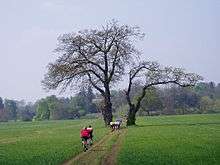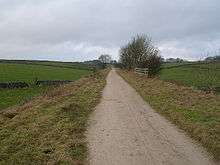Bridle path
A bridle path, also bridleway, equestrian trail, horse riding path, bridle road, or horse trail, is a path, trail or a thoroughfare that is used by people riding on horses. Trails originally created for use by horses often now serve a wider range of users, including equestrians, hikers,[1] and cyclists. Such paths are either impassable for motorized vehicles, or vehicles are banned. The laws relating to allowable uses vary from country to country.[2][3]
In industrialized countries, bridle paths are now primarily used for recreation. However, they are still important transportation routes in other areas. For example, they are the main method of traveling to mountain villages in Lesotho.[4] In some areas, bridle paths developed as transport routes where the terrain was so steep that the route was impassable by wheeled wagons and vehicles, as for example, Bridle Path, New Zealand, an early transport route in Christchurch. However, In England and Wales a bridle path now refers to a route which can be legally used by horse riders in addition to walkers, and since 1968, by cyclists.
In the US, the term bridle path is used colloquially for trails or paths used primarily for people making day treks on horses, and usually used only on the east coast, whereas out west the equivalent term is trail. The term "bridleway" is rarely used in the U.S. Most of the time horses are presumed allowed to use trails in America unless specifically banned, although rules differ among locations.[5]
In some countries long distance multi-use trails have been created, including the Bicentennial National Trail in Australia, one of the longest marked multi-use trails in the world, stretching 5,330 kilometres.[6] Rail trails can often be used by equestrians.
Bridleways in the United Kingdom

England and Wales
In England and Wales a bridleway is "a way over which the public has a right of way on foot and a right of way on horseback or leading a horse, with or without a right to drive animals along the way."[7][8] Although Section 30 of the Countryside Act 1968 permits the riding of bicycles on public bridleways, the act says that it "shall not create any obligation to facilitate the use of the bridleway by cyclists". Thus the right to cycle exists even though it may be difficult to exercise on occasion, especially in winter. Cyclists using a bridleway are obliged to give way to other users on foot or horseback.
Long distance bridle trails

A number of long distance multi-use trails have been created in England, including three National Trails, the Pennine Bridleway, 192 km (119 miles), The Ridgeway, 139 km (86 miles), and South Downs Way, 160 km (99 miles).[9]
Scotland
In Scotland there is no legal distinction between footpaths and bridleways, though it is generally accepted that horse riders and cyclists may follow rights of way with suitable surfaces.
U.S.
The United States has few if any formal designations for bridle paths, though horses are generally allowed on most state and federal trails, roads and public routes except where specifically restricted. Often, horses under saddle are subject to the same regulations as pedestrians or hikers where those requirements differ from those for cyclists. In most states, horses are classified as livestock and thus restricted from areas such as the right of way of the interstate highway system, though generally permitted to travel along the side of other roadways, especially in rural areas.
Urban bridle paths exist in Philadelphia's Fairmount Park (most notably Forbidden Drive along the Wissahickon Creek)[10] and New York City's Central Park
Some trails managed by the U. S. Forest Service and other governmental entities may restrict access of horses, or restrict access during certain times of the year. For example, horses are allowed on the American Discovery Trail, which crosses the country,[11] but only on specific sections of the Appalachian Trail.[12] Access to trails and pathways on private land is generally left to the discretion of the landowner, subject to the general trespass laws of each of the 50 states.
| American Discovery Trail | |
|---|---|
|
The American Discovery Trail, including its northern and southern routes. | |
| Length | 6800 mi (10944 km) |
| Location | United States |
| Use | Hiking, Horseback Riding, Mountain Biking |
| Elevation | |
| Highest point | Argentine Pass, 13,207 ft (4,025 m) |
Rail trails

Rail trails/paths are shared-use paths that make use of abandoned railway corridors. They can be used for walking, cycling, and often horse riding as well. The following description comes from Australia, but is applicable equally to other rail trails that exist throughout the world.
- "Following the route of the railways, they cut through hills, under roads, over embankments and across gullies and creeks. Apart from being great places to walk, cycle or horse ride, rail trails are linear conservation corridors protecting native plants and animals. They often link remnant vegetation in farming areas and contain valuable flora and fauna habitat. Wineries and other attractions are near many trails as well as B&B's and other great places to stay." [13]
Most trails have a gravel or dirt surface suitable for walking, mountain bikes and horses.
See also
- Byway
- Equestrian use of roadways
- Footpath
- Green lane
- List of rail trails
- Long distance trail
- Public right of way
- Trail riding
References
- ↑ Old Bridle Path trail in NH White Mountains
- ↑ "bridle path". Merriam-Webster's Online Dictionary. Merriam-Webster. Retrieved July 24, 2010.
- ↑ "Bridle Path". The American Heritage Dictionary (Fourth ed.). 2007.
- ↑ "Lesotho." Encyclopædia Britannica. 2007. Encyclopædia Britannica Online. 24 June 2007
- ↑ Concord Monitor: "N.H. drops plans to limit horse use of state trails after complaints"
- ↑ Bicentennial National Trail Retrieved 29-11-2013.
- ↑ s 329, Highways Act 1980 and s 192, Road Traffic Act 1988
- ↑ A Dictionary of Law Enforcement. Oxford University Press, 2007
- ↑ Ride-UK: National Bridle Route Network provides details of other long distance bridle routes at http://www.ride-uk.org.uk.
- ↑ City of Philadelphia: Horse Stables. City of Philadelphia http://www.phila.gov/ParksandRecreation/placestogo/facilities/Pages/HorseStables.aspx. Retrieved 2015-09-13. Missing or empty
|title=(help) - ↑ <http://www.discoverytrail.org>
- ↑ http://www.discoverytrail.org
- ↑ Railtrails Australia: <[http://www.railtrails.org.au/what-are-rail-trails/introduction>]
External links
-
 Media related to Equestrian trails at Wikimedia Commons
Media related to Equestrian trails at Wikimedia Commons - Byways & Bridleways Trust: <http://www.bbtrust.org.uk>
- The Long Riders Guild: <http://www.thelongridersguild.com>
- National Federation of Bridleway Association (UK): article on bridleway usage by motorists (2004)
- New Zealand Bridleways: <http://www.nzbridleways.info>
- Riding trails in England and Wales: <http://www.emagin.org/Routes_by_Region.aspx>
- Bridleway Map — a map of bridleways in the UK <http://bridlewaymap.com>
